Cultivation over natural supports and as ground cover
 Clematis feel at home growing through living supports, such as perennials, dwarf shrubs, bushes, and trees. They are natural companions in the wild and, as Nature is unrivalled in arranging the plantings for the best display, this manner of growing is well worth recreating in every garden. Clematis compensate for the seasonal flowering gaps by providing color when other flowers are lacking, and thus extend the glory of the garden. Remember, however, that you have to conform the growth habit of the clematis with the size of the shrub or the tree. Plant them near bulbs and hard prune in spring. Consequently, tulips and daffodils will bloom undisturbed throughout spring, and after their retreat into dormancy clematis will clothe them with a richly colored carpet.
Clematis feel at home growing through living supports, such as perennials, dwarf shrubs, bushes, and trees. They are natural companions in the wild and, as Nature is unrivalled in arranging the plantings for the best display, this manner of growing is well worth recreating in every garden. Clematis compensate for the seasonal flowering gaps by providing color when other flowers are lacking, and thus extend the glory of the garden. Remember, however, that you have to conform the growth habit of the clematis with the size of the shrub or the tree. Plant them near bulbs and hard prune in spring. Consequently, tulips and daffodils will bloom undisturbed throughout spring, and after their retreat into dormancy clematis will clothe them with a richly colored carpet.
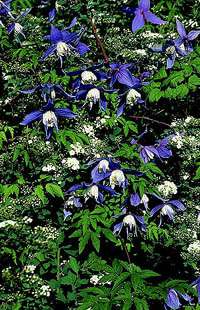 Clematis Atragene Group 'Frances Rivis' (alpina) in Spirea vanhouttei |
Summer-flowering varieties, hard pruned in spring, are ideal for this purpose. You can choose any of the following: Clematis 'Błękitny Anioł', Clematis 'Comtesse de Bouchaud', Clematis 'Ernest Markham', Clematis 'Etoile Violette',
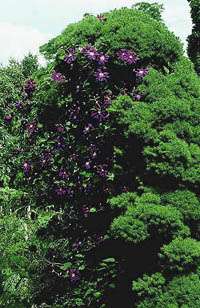 Clematis 'Etoile Violette' on Picea glanca 'Conica' |
Clematis 'Ville de Lyon', Clematis 'Warszawska Nike', Clematis 'Xerxes'. If you don't want clematis to cover the supporting plant completely, you should choose varieties with a more delicate silhouette, ideally from the Viticella Group, such as 'Little Nell', 'Betty Corning', 'Emilia Plater', 'Kermesina' or 'Purpurea Plena Elegans', but all the cultivars from the Atragene Group, the Texensis Group and the Integrifolia Groupare also well suited for this purpose. It's best at the beginning to let the stems sprawl over the ground without any restraints. When the plant has spread out and new shoots are woody, the risk of damaging or even breaking the stems reduces, and you can safely arrange the plant according to your needs.
Clematis thrive in loamy, moderately moist and well-drained soil. If the supporting plants (e.g. heath) require little watering and fertilization, you can ensure proper growing conditions for clematis by burying at the base of the plant a flowerpot or a wide tube filled at the bottom with little stones. This solution enables a direct supply of water and fertilizers to the clematis roots. If the soil the host is cultivated in is too acid, clematis should be planted in a small distance (30-60 cm), where the soil conditions are more favorable.
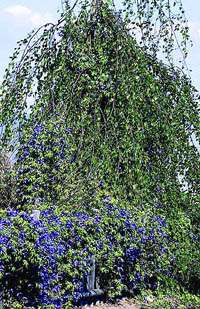 Clematis alpina 'Pamela Jackman' on Betula pendula 'Youngii' |
Clematis varieties are very effective, when grown through trees or shrubs. A majority of shrubs flower in spring (e.g. lilacs, jasmine, forsythia, guelder rose ). Therefore, if you plant in their neighborhood a clematis from the Viticella Group, or a large-flowered hybrid reaching its blooming peak later in the season, (varieties requiring pruning of type B), and cut it back hard each spring, you'll have a continuous show in the garden from June till September, first, during May and June, created by a flowering shrub, followed in summer by clematis blooms. In like manner you can use the cultivars from the Integrifolia Group to grow over compact, spring-blooming shrubs (e.g. azaleas).
The following varieties are well suited for growing into medium-sized trees or shrubs : Clematis 'Comtesse de Bouchaud', Clematis 'Duchess of Edinburgh', Clematis 'Ernest Markham', Clematis 'Etoile Violette', Clematis 'Polish Spirit', Clematis 'Generał Sikorski', Clematis 'Hagley Hybrid', Clematis 'Gipsy Queen', Clematis 'Jan Paweł II', Clematis 'Jackmanii', Clematis 'Star of India', Clematis 'Madame Julia Correvon', Clematis 'Ville de Lyon', Clematis 'Mad. Le Coultre', Clematis 'Warszawska Nike', and all cultivars from the Viticella Group, the Atragene Group and the Texensis Group. If you want a clematis to grow up tall trees you should choose a plant from vigorous varieties, such as Clematis 'Bill MacKenzie', Clematis 'Paul Farges', Clematis montana var. rubens, or Clematis 'Lambton Park'. Many climbers other than clematis are also well suited for training up trees. In sun exposed locations you might plant Trumpet Creeper , while ivy, Climbing Hydrangea, Dutchman's Pipe, and Japanese Hydrangea will perform best in shade.
Clematis planted over a conifer, its lovely flowers scattered over the evergreen, will enhance the beauty of every garden. Varieties should be chosen according to the color of flowers and the rate of growth of a coniferous plant, the general rule being the weaker a conifer, the less vigorous and dense a clematis. For instance, plants with deep green foliage (e.g. yew) contrast nicely with pale-colored varieties such as Clematis 'Comtesse de Bouchaud', Clematis 'Hagley Hybrid', Clematis 'Mrs. Cholmondeley', or Clematis 'Nelly Moser'. All cultivars from the Viticella Group or the Atragene Group will also give a spectacular display. Conifers with silvery foliage will look their best when interwoven with brightly colored varieties e.g. Clematis 'Kardynał Wyszyński', while yellow-leafed plants blend harmoniously with blue-flowered clematis, such as 'Mrs Cholmondeley'.
The old adage "a warm top and cool bottom" is ever true in most cases, so it's best to plant clematis on the north face of the supporting plant, so that the base of the vine gets some shade. Clematis should be planted within a distance from a tree or shrub. The interval depends on the size of a supporting plant, and can reach up to 1m. You should connect the clematis to the plant it will scramble over with a rod, bamboo stick, or a wire, thus securing the stems from damage.
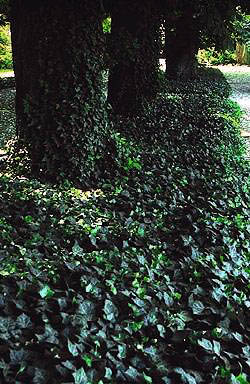 Hedera helix (Ivy) growing on the tree |
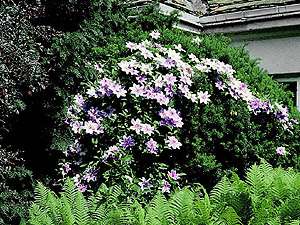 Clematis 'Nelly Moser' on Taxus |
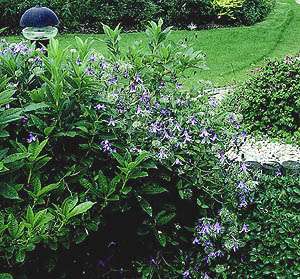 Clematis integrifolia 'Olgae' in Azalea |
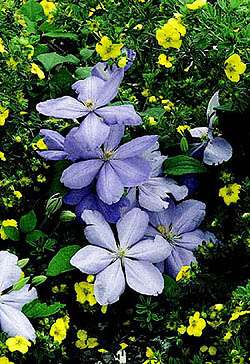 Clematis 'Mrs. Cholmondeley' on Potentilta |
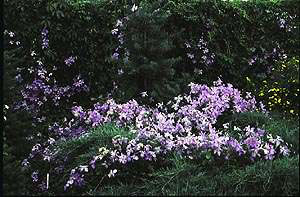 Clematis 'Emilia Plater' |
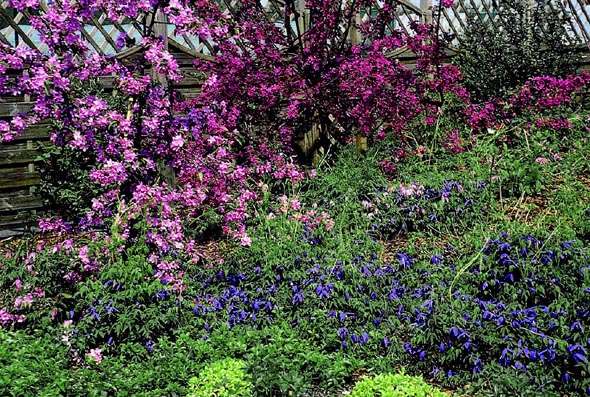 Clematis alpina 'Pamela Jackman' on Malus |
Many climbers make good ground cover if left to grow with no supports, spreading over the ground and creating attractive, sometimes colorful, carpets. They can succesfully replace lawn, be planted under trees and shrubs, and are an ideal solution on borders and banks. Ground cover plants form a dense mat of uderground stems that consolidates the soil to prevent wind erosion, surface run-off and excessive drying, and keeping weeds at bay. Ground cover plants greatly facilitate maintenace of greenery by reducing the amount of time and money spent, as well as improve the overall effect. They are ideal for both large and small gardens, and also for public greenery. However, in order to achieve the best results plants should be chosen according to the location, the size of area to be covered, and to the growth habit of neighboring plants. Depending on your needs you can choose between climbers, which are quite vigorous in habit, and slower growing dwarf shrubs. These resistant and undemanding plants will adorn your garden with a mass of foliage and/or flowers.
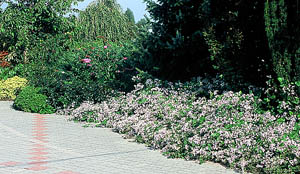 Clematis Grupa Heracleifolia 'Praecox' |
Clematis Heracleifolia Group 'Praecox' is by far the best ground cover clematis. This resistant and undemanding cultivar thrives equally well in full sun and semi-shade.
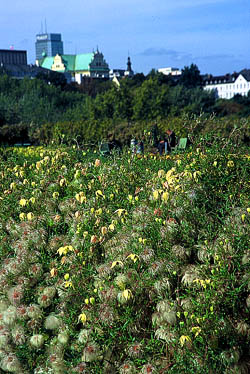 Clematis Tangutica Group growing over Warsaw University Library |
Its deep green leaves form a dense carpet suppressing weed growth, and in summer the plant is veiled with masses of pinkish-mauve flowers gathered in large panicles. If the area to cover isn't very large, some other herbaceus varieties are also fit for the purpose, especially from the Integrifolia Group (e.g.: Clematis 'Arabella'). For larger sites you may successfully use many cultivars from the Atragene Group, the Viticella Group or the Tangutica Group. These varieties, however, are a bit more demanding than Clematis 'Praecox', so special care should be taken to properly choose the plants for the conditions on the location, using either information in the encyclopedia section or the search engine of this application.
There are also other climbers well suited for creating covers e.g.: Virginia Creeper (perfect for large areas), Euonymus fortunei (among which the best cultivar to this end is 'Coloratus' - a vigorous, resistant and undemanding plant). In sheltered positions it's best to use Japanese Honeysuckle 'Aureoreticulata' (yellow-green foliage), 'Halliana' (profuse and long-lasting bloom of fragrant flowers),and Akebia quinata . A yet another excellent ground cover plant, other than a climber is a dwarf shrub Vinca minor .
Another good thing about ground cover plants is their diversity when it comes to growing conditions. You can choose varieties that thrive in semi-shade or even in full-shade (e.g.: Common Ivy, Euonymus fortunei , Climbing Hydrangea , Japanese Hydrangea-vine and a dwarf shrub - Vinca minor ), and such areas always pose a challenge for a gardener. There are also other plants that favour sunny, slightly dry sites (e.g.: the cultivars from the Tangutica Group).
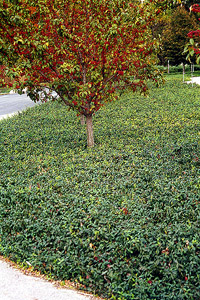 Euonymus fortunei 'Coloratus' |
Planting. Good soil preparation is imperative and removing all the weeds, rubble and other impurities is important, as is enriching the soil with well-rotted farmyard manure or garden compost. Spacings should be determined according to the growth habit of the plants chosen. It's advisable to mulch the ground in between plants.
Maintenance. Watering plants is vital and doing it correctly is amongst the most important jobs in the garden. One of the best systems to this end is a drip or trickle irrigation system using a special tube laid just beneath the ground. During the first 2-3 years in spring (April-May) a fertilizer should be applied. In subsequent years feeding should be be done only when needed. You should remove all withered stems, as well as the shoots that are either too high or starting to outgrow its alloted space. The main pruning is best done in spring, while the correcting one can be accomplished during the vegetation period according to the needs.













